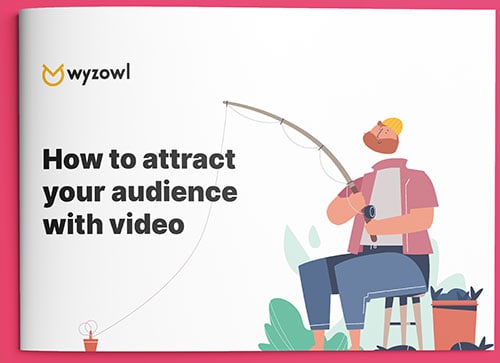Last updated on 22nd November 2023
For all its many benefits and advocates, Instagram remains a mystery to many businesses.
Particularly B2B.
How can you reconcile the traditional norms of B2B marketing – straight-laced, professional, formal – with a platform that’s monopolised by influencers, foodie-filters and wanderlust?
How does that translate into businesses selling products, services and software to other businesses?
In this post we’ll lay out 28 ideas to inspire you – different types of content you can post to get more mileage out of your Instagram presence.
1. Data, data, data!
We all know how important numbers are – and they can be a great advantage on Instagram, too.
Not only does original data constitute interesting, original, shareable content: it can help build the case and demonstrate how sorely your product or service is needed. (In short, it’s a good way to sell without actually selling.)
It’s incredibly easy to build surveys and generate original data using SurveyMonkey and then share your findings with the world.
This is what we do each year through our State of Video Marketing survey. Promoting the stats through images or basic animated graphics helps spread the word in a creative, visually appealing way:
You don’t necessarily have to generate the data yourself, though. You can simply use graphic design software to visualise compelling data generated by other brands (with appropriate credit given, of course.) Hubspot do this pretty effectively:
And of course, as always with Instagram, you don’t have to simply add these posts to your feed. You can use Story functionality to create content like the below example, produced by SimplyHealth.

2. Lifestyle product shots
Dealing in physical products? Product photography is an obvious choice for Instagram content.
What’s important, though, is to recognise that the product photos you share on Instagram, shouldn’t be the sort of plain, white-background product detail shots you tend to see on website product pages. Bluntly, that’s too dry. Too boring.
Instagram, if nothing else, is an aspirational lifestyle platform.
It’s at its best when it offers excitement and inspiration – spiking the senses with vibrant colours and authenticity.
That’s why you should show your product in the ‘real world.’ In use, if possible.
Dipping into the B2C world for a few examples of why this is effective. Here we see the packaging of Nescafe’s Dolce Gusto Flat White coffee pods…
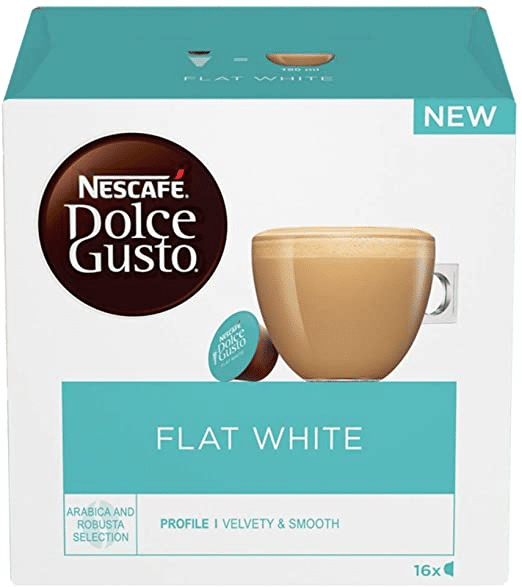
Vs. an Instagram post promoting the product…
Setting up this shot is so much more of an evocative way to sell the product. We can almost taste and smell the coffee, we can feel the warmth of the cup on our hands.
Similarly, here’s Citizen watch model number CB5918-02L…

And here’s Citizen’s post promoting that watch:
The image sends so many aspirational messages about who the product is for: that guy is young, he’s smart, he’s professional. He’s doing well for himself. He has places to go, people to see.
It goes from being a ‘watch’ to being a ‘lifestyle product.’
“Ok sure, but that’s easy for B2C. What about B2B?”
Well, there’s no need to reinvent the wheel here.
Instead of showing your products on a plain background, photograph them ‘authentically’ in environments where you’d see them actually being used.
3. Behind the scenes
The saying that ‘people buy from people’ has shown itself over decades to be true.
As a visual channel, Instagram offers a tremendous opportunity for brands to personalise themselves by showing the ‘making of’ their products, or sharing candid shots from around the workplace.
This can be done quickly and inexpensively.
It often just requires the forward thinking of grabbing your phone and snapping something.
If you want to invest more significantly, you might want to follow the IBM model – they actually have a ‘lifeatIBM’ Instagram account which serves two purposes: humanising the brand, and advertising daily life at IBM to potential hires.
But don’t run before you can walk: sharing ‘behind the scenes’ content among other things on your main company account is a great first step.
4. Day in the life
This an expansion of the above idea – but you might want to post and show what actually goes into a whole day making/selling your product.
This helps humanise your brand and show how hard you work.
You can do this as a series of posts, or use Instagram’s stories feature. (The latter is probably better, as stories disappear after 24 hours and your followers won’t get mad at you for spamming their timeline with multiple posts. HOWEVER, you can ‘highlight’ stories so they remain on your timeline forevermore.)
5. Ask, don’t tell
Social media is at its best when it’s a conversation – a two-way street.
So, as much as the onus is on us as publishers to put content out there, it’s also incredibly valuable to LISTEN!
Instagram can be a great way to invite opinion and kickstart debate around a topic.
Some great questions to ask might be:
- What do you think about [latest industry events]?
- What do you love about your job?
- What do you NOT like about your job?
- What’s your biggest frustration at work right now?
- What advice would you give your 21-year-old self?
There’s a double benefit here: not only is it good for you to learn a little about your audience and understand them better, it’s also a good way to generate engagement – likes and comments.
Your audience engaging with your content sends a powerful signal to Instagram’s content delivery algorithm: “We like this content and we want to see more of it!”
This can increase your serve rate and make sure more of your audience see your future content organically. A real win-win!
6. Post a tip, hack or tutorial
In business, success is really a byproduct of helping enough people.
Generally – the more people you help, the more successful you’ll be!
And it’s the same with Instagram. If you consistently share content that really helps people do stuff, you can’t fail to be successful.
What helping people means specifically will vary depending on your product, audience and a range of other factors.
But ask yourself:
- What do you know that a lot of people don’t?
- What do you wish you’d have known a year ago?
- What do people struggle with most in your industry?
- What’s a big problem that your software/product can solve?
- What can you do with your software/product that is visually impressive or looks cool?
There are lots of different ways to do tutorial/help videos, from vlog-style videos….
Simple illustrations that pack in as much value as possible…
And (although this is clearly a B2C example!) you can even lay out ‘quick cut’ videos that show the actual process by which something is made or done (even if it’s not as exciting as this banging recipe…)
Ultimately try to offer as much value and help to your audience as possible as this is what will build a committed long-term audience.
7. Contests and giveaways
Giveaways are more widely associated with B2C but people always like a freebie.
It’s important to focus on the right incentive AND the right action. Two questions need to be answered correctly for a successful contest:
- What do your audience want to win?
- What do you want them to do?
Commenting, liking, following, tagging a friend, etc. are all valid actions depending on whether you’re looking to increase engagement on your page, increase your follower count, and so on.
8. Blasts from the past
Instagram is really a storytelling platform – and everyone loves a story of growth.
#tb or #tbt (throwback Thursday) is an actual thing on Instagram.
And, whereas for regular users it’s a chance to throw back to great memories (or unfortunate haircuts), it gives brands an interesting opportunity to reflect on their own growth and evolution.
Use that hashtag and throwback to your early early days: an old logo, an old iteration of your product.
This can be a cool way to #humblebrag – and subtly demonstrate how far you’ve come.
For example, Ahrefs shared a pic of their interface from 2011. Check out the comments!
9. Hiring
Attracting talent seems to be getting harder and harder.
But Instagram, increasingly, can play a role here.
Lots of brands share their latest vacancies on Instagram – which widens the potential talent pool to include a bunch of people who are already aware of, and potentially invested in your brand. These people can often be extremely good hires.
But, again, at the risk of upsetting the #nofilter crowd, it also again projects a vision of growth and success – which never hurts your brand.
If you’re growing, don’t limit yourself to traditional recruitment means – let people know on Instagram with simple ‘We’re hiring’ job posts.
If you really wanna commit to this idea, again, you might consider setting up a dedicated channel as an employer branding tool – this is something companies like Salesforce and Marriot do very well.
10. Instagram takeover
An Instagram takeover is essentially where you let ‘somebody’ take over your channel and assume posting responsibility for a set period – usually a day or shorter. (Or, of course, you could take over ‘somebody’ else’s channel!)
Who that ‘somebody’ is will depend on your goals.
If you’re looking to grow your audience, partner with an established brand (non-competing!) where there’s at least some overlap in interest.
For example, this partnership between HubSpot (marketing software) and WeWork (flexible workspaces company) has a lot of good crossover – with a lot of good upside for both.
11. Completed work
For service businesses or creatives, Instagram can almost double up as a portfolio.
You have to remember that every social media tool from Facebook to LinkedIn to YouTube to Twitter and beyond is essentially its own sort of search engine.
If people discover you on Instagram, and use what they see to make a snap judgement – you want them to see your best work.
So, as well as all the other ideas we’ve shared so far, don’t forget to showcase your best completed work and most interesting projects, and put your best foot forward.
12. Mission/values content
Today’s buyers have more choice at their fingertips than ever before, and, increasingly, that makes B2B relationships exactly that – relationships, rather than mere transactions.
When people buy from you, they buy into you.
That – plus perhaps a generation shift towards a more socially aware culture – is why so many businesses really need to have a mission, values: a vision for how they want to change and better the world.
And that stuff can’t just sit in a company policy handbook or a document on your company server. It needs to be front-and-centre.
Instagram is a great platform for posting content that showcases your values and reminds people you stand for more than ‘just’ a product.
For example Salesforce honouring Black History Month to demonstrate commitment to equality in the workplace…
And HubSpot demonstrating commitment to workplace culture…
Or Screwfix demonstrating their philanthropic side through the Screwfix foundation…
Posting about things you care about as a brand is a good way to remind people it’s not just a transactional thing of buying your products, but you’re real people with a conscience and a vision for a better world.
13. ‘Swipe’ content
‘Swipe’ content is, as you might expect, content that you need to ‘swipe’ through.
This can be a simple but effective way to gain attention as a user is scrolling their timeline. Suddenly, they see something ‘incomplete’ or mysterious like this…
How could you NOT swipe?
This seems trivial enough but capturing that extra second or two of engagement is valuable…why?
Because: The act of swiping through the images will be considered an ‘interaction’ by the Instagram algorithm, as well as keeping people on that post for longer.
14. Customers/UGC
One mistake loads of brands make is talking too much about themselves.
Really, particularly for B2B companies, your whole business is the transformation of your customer from state ‘A’ to state ‘B.’
That’s why it’s often much more powerful to show how you’ve helped others.
Mailchimp do this well with their customer spotlights:
While Slack, too, do a great job of letting their happiest most successful customers do the talking on their behalf…
There’s real logic behind this approach, when you consider that 95% of people say that reviews – whether positive, or negative – influence their purchasing decisions, and 9 out of 10 people say they trust what a customer says about a business more than what that business says about itself.
15. Ads
Ok, we’re flying through this list but this is probably the most obvious suggestion so far.
We all focus on organic reach as the holy grail, and there are plenty of good reasons for that, but with organic reach on all channels sinking by the year (so those platforms can be more effectively monetised,) it can simply be hard to get off the ground.
Sometimes, for a quick fix, paid ads are a really good investment.
Covering the dizzying array of different types of ad available on Instagram is a whole topic on its own, with image, stories, videos, carousel ads, collection ads, explore ads, and shopping ads all at your disposal. This is a useful guide to check out if you’d like to take your research further.
All we would say is that the usual top tips apply with paid ads – make sure to start small, test what works, and scale as you understand better. It’s very easy to throw away money on paid advertising that gets you nowhere, so make sure you build yourself up to it!
16. Inspiration
Instagram is predominantly a lifestyle platform. And often the easiest, richest way to inspire your audience is by standing on the shoulders of giants, so to speak – curating inspirational quotes and ideas that resonate with your brand and world view.
Obviously you can simply Google quotes – search something like “quotes about <theme>.” You can then have your design team create these quotes as vibrant, on-brand images – or, if you’re going this alone, use free software like Canva to add this to imagery and create highly shareable content.
Simply select ‘Instagram Post’ on the Canva home page and you’ll see a range of great, easy-to-edit templates that are the right dimensions for a post on Instagram.
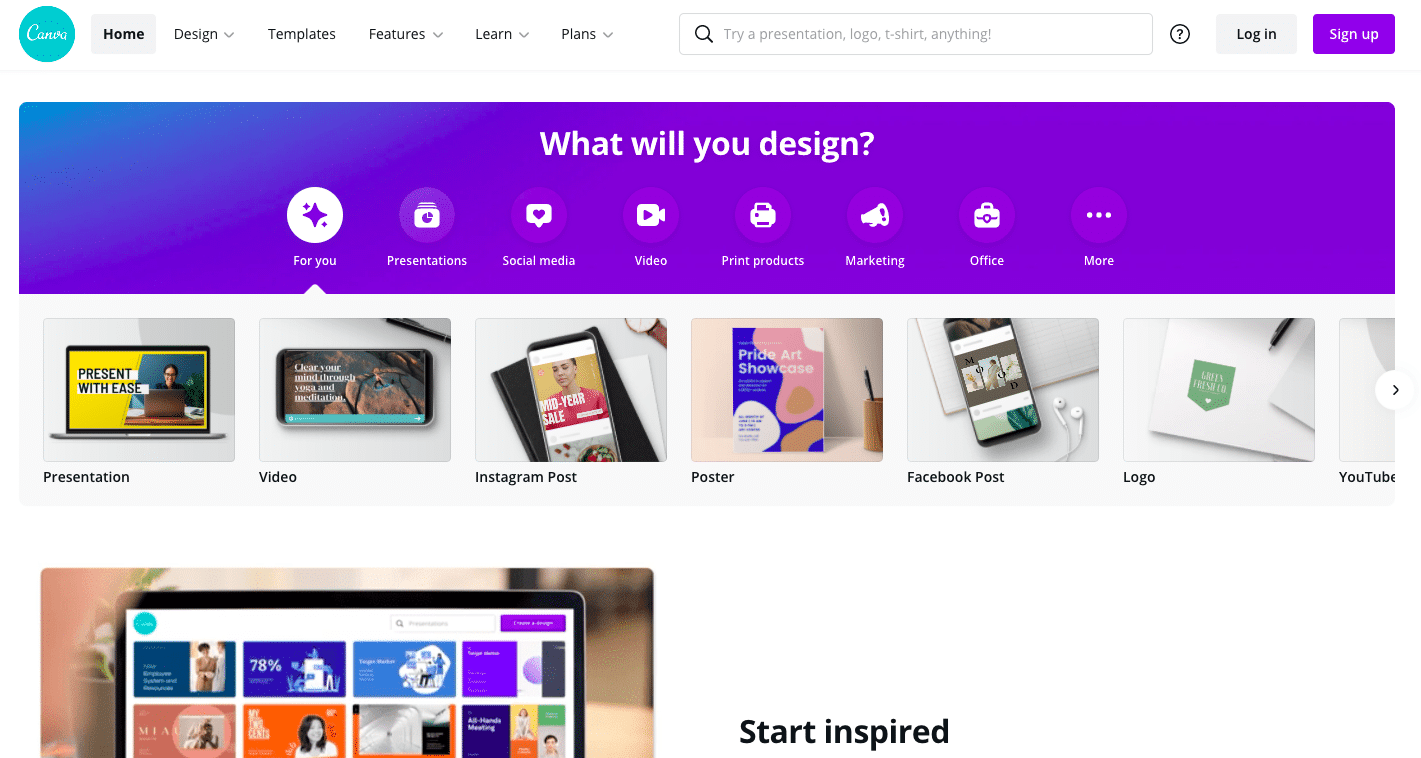
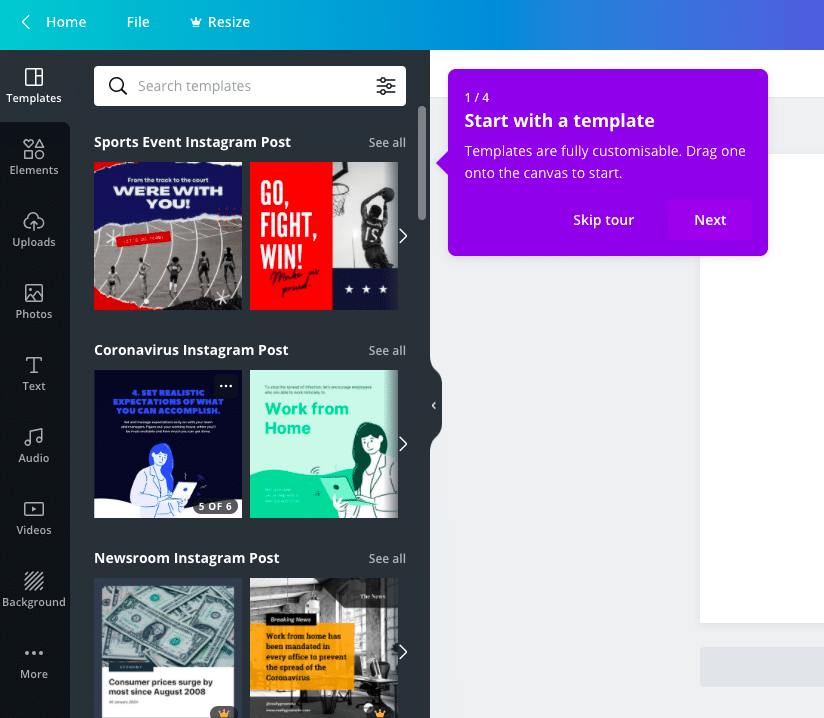
17. Links to content & events
Instagram isn’t just a content delivery platform in its own right – but also a vehicle to promote content you publish elsewhere.
Just posted a great blog, a new ebook, holding a webinar or have a new event video? Get it promoted on Instagram! Create a compelling preview image, write a summary of the value you’re offering, and put your link in the bio.
18. Topical/timeliness/newsjacking
If you’ve ever seen the ‘National Day Calendar’ you’ll know that there’s essentially a national or worldwide day for everything!
This isn’t the most serious content to promote but it does give you some opportunities to create and share some fun content around things that are tangentially related to your brand.
For example, Grammarly took the opportunity to post on ‘Random Acts of Kindness Day.’
It’s also a good idea to generally keep abreast of the news – there are often stories that everyone talks about that you can hop on the back of to promote your brand, raise a giggle among your existing audience and – if it’s clever and witty enough! – potentially even reach a wider audience by going viral.
19. ‘Game’ posts
Ok, maybe this one’s a little gimmicky – but you can easily use Instagram’s visual platform to share minigames like word searches, anagrams, and more.
This can be a surprisingly impactful way to increase reach and engagement.
Take Grammarly’s Valentines Day word search for example…
If you’re looking to further generate engagement, this is a cool idea by Mailchimp – utilising Instagram’s single-click ‘play/pause’ functionality to create a mini-game which chooses your business personality type…

20. Polls
People love to vote!
And remember, the opposite of what you want on Instagram is silence and ambivalence.
Any lever you can pull to get people to do ‘something’ with your content – like, comment, spend a few extra seconds, swipe, watch – you should pull.
There are a number of ways to do polls. You can run them directly through stories…
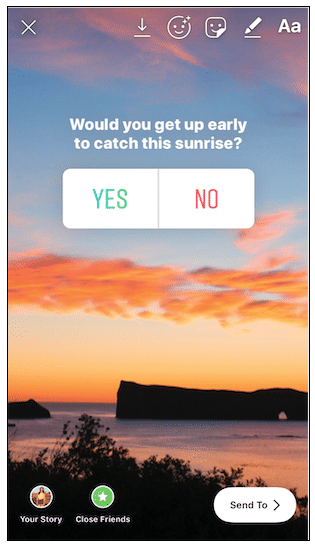
Do it through posts – e.g., like for option A, comment for option B…
Or even simply invite people to comment, although this obviously does away with the numerical factor of voting.
21. Reels
Reels – originally IG’s attempt to compete with short-form video titan TikTok – are now taking over the platform.
They therefore present a great opportunity to create bespoke 15 second video clips. You could use these to share information and advice, or just have fun with some down-and-dirty, quick shot viral sketches.
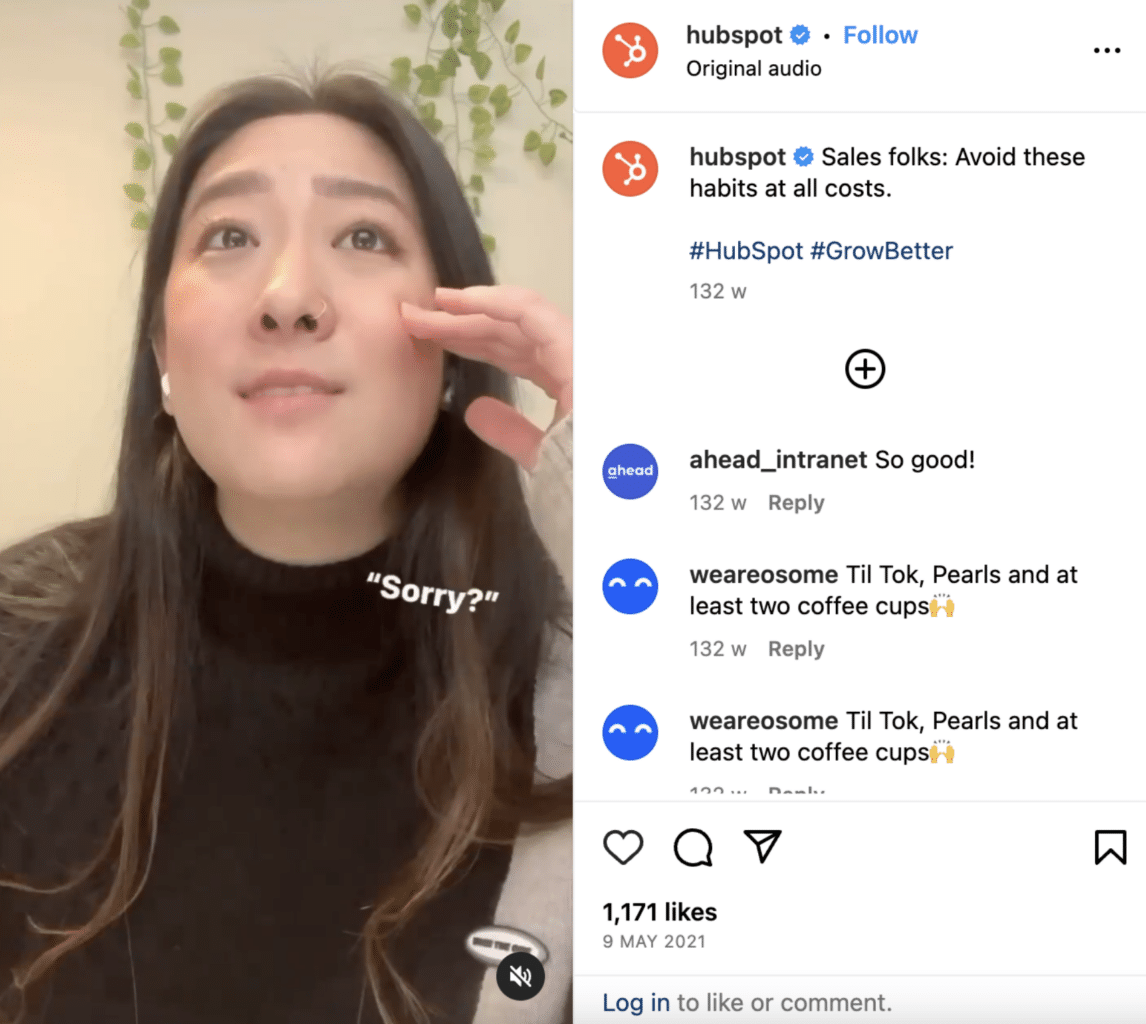
And, unlike stories, which expire after 24 hours, Reels content is permanent.
22. Countdowns
We’re all looking forward to something, right?
Instagram has a countdown feature which can be applied directly to your Stories, counting down to a specific date and time…
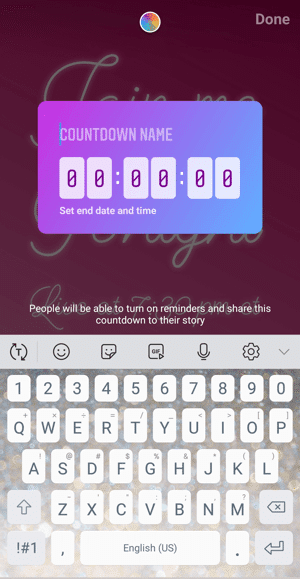
So, if you’ve got something exciting coming up for your brand – an event, a product launch, a website reveal, a rebrand, whatever – you can use this functionality to build a buzz among your audience and count down to the exact moment all is revealed.
23. Q&A
We’ve already mentioned that Instagram, like all social media channels, is at its best when it’s a two-way street of asking and listening.
Q&A functionality is incredibly powerful within Instagram. Again, it’s best implemented through Stories, as Q&A is an actual ‘sticker.’ Questions are invited through one page of your story. And questions that are submitted, are displayed anonymously along with your answer.
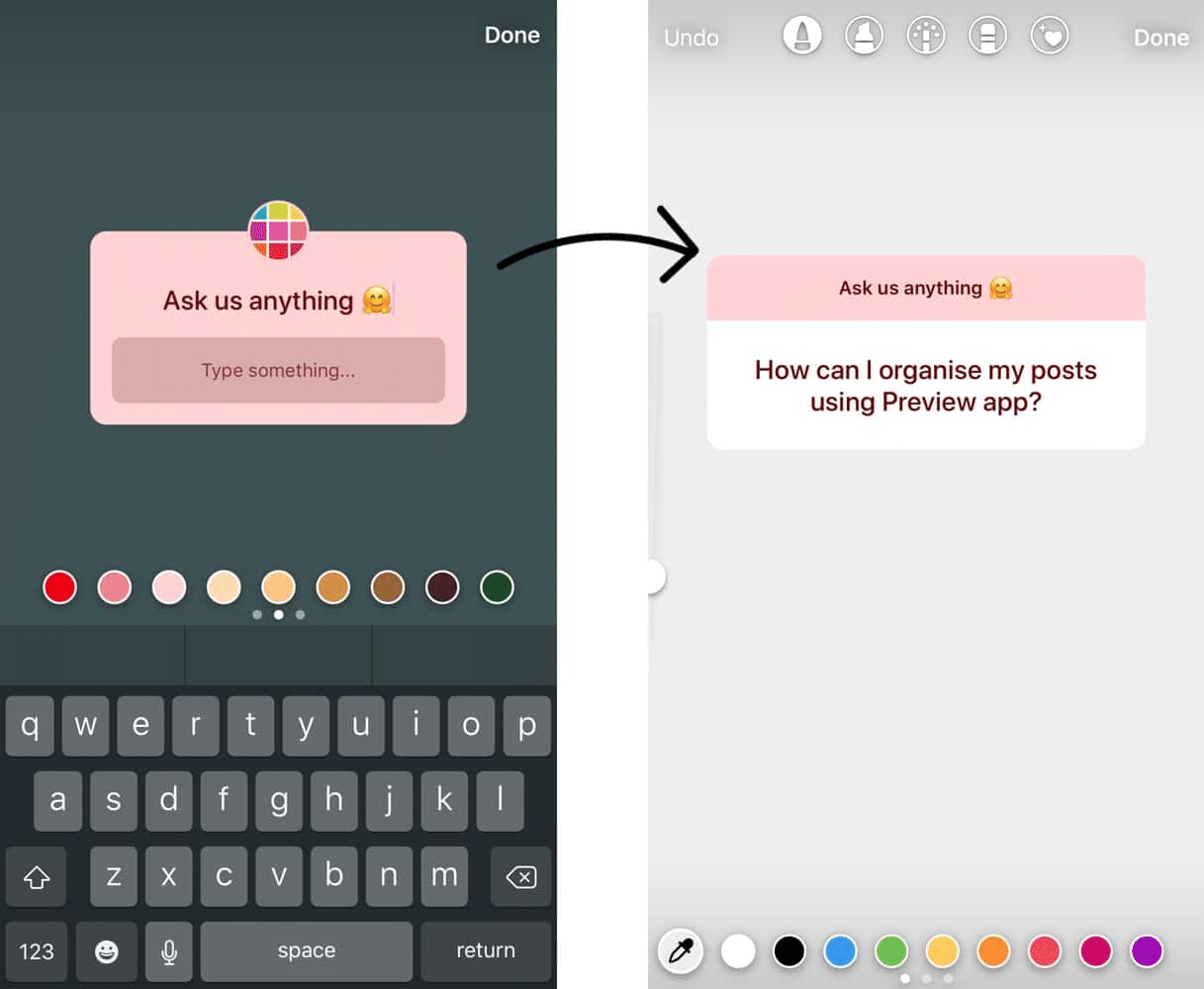
If you’re worried about getting radio silence from your audience, you might want to prepare some anonymous questions to answer – this might get the ball rolling.
24. Instagram Stories highlights
This is a continuation of an idea we’ve already suggested, and basically a way to format your Instagram profile.
As we mentioned earlier, stories, by default, disappear after 24 hours, but you can override this by ‘highlighting’ them.
The beautiful thing here is that these ‘highlights’ are all laid out front and centre of your Instagram profile AND you can set a cover for them.
This can be used to highlight past events, product launches, etc – grouping story content together into hierarchically organised bunches.
Or if you have different ‘niches’ you can use it to organise interesting stories/content together on your Instagram profile page like HubSpot do…
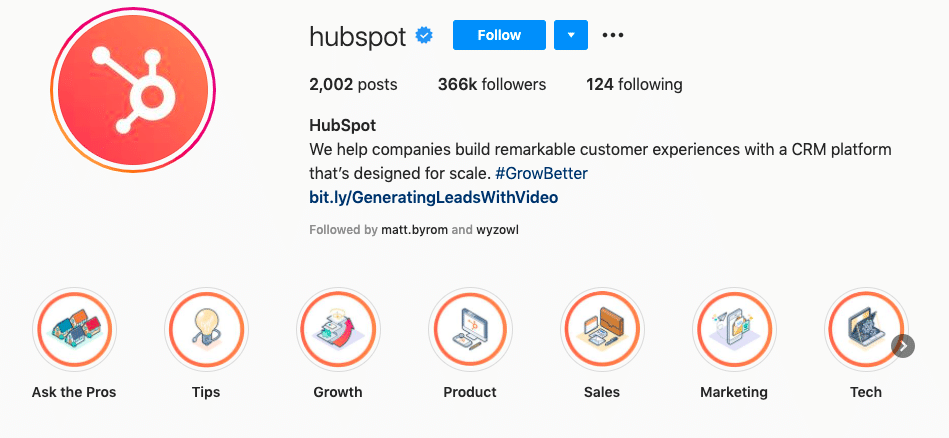
25. Your founder story
There’s no doubt that brands can often seem faceless.
And yet behind pretty much every business, there’s a compelling story of creativity and innovation that would inspire anyone.
Sharing the story of why you were formed – by who – and how far you’ve come is a great way to personalise, and address your ‘reason’ for being.
Again, it reframes the narrative, almost from being a ‘business’ to being a ‘cause.’
26. What you’re reading
Contrary to what the naughty kids told you at school, books are cool. Books will always be cool!
There’s a reason why, in every TV interview anyone did from home during the coronavirus pandemic, they sat themselves in front of a bookcase stacked with books, each of which said something about their personality and interests. The NY Times called this the ‘credibility bookcase’ and said it was quarantine’s hottest accessory!
Consider Instagram your personal book case. Sharing the books you’re reading is a great way to demonstrate that you care about the industry, and personal growth/development. It says you’re conscientious, invested in improvement. AND it strikes up interesting conversations with your audience if they’re reading the same things.
JP Morgan went as far as to create a summer reading list:
27. Gratitude
What if, rather than using the platform to get more – you used it to say thank you?
Customer gratitude is a really good signal to send out. It shows that you care about the customer experience and can help build trust.
28. Quirky, humorous content
Ultimately, as you’ve seen from some of the examples we’ve shared so far, the lines between B2B and B2C content have become less clear than ever.
Sometimes acting like a B2C brand – or even just a person – is a great start.
Because people ultimately enjoy quirky, humorous and whimsical content regardless of whether they’re buying for personal use, or making business purchasing decisions.
Mailchimp are great at doing this – using animated graphics to create slightly offbeat snippets of content that furthers their general brand message.
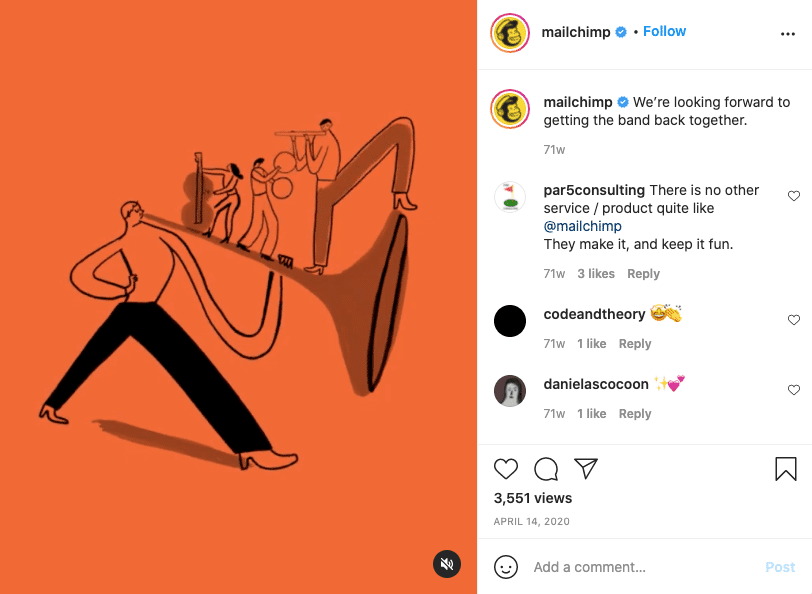
HubSpot, too, create meme-like content that you’d expect to see from a B2C brand, and in doing so, build empathy with their audience.
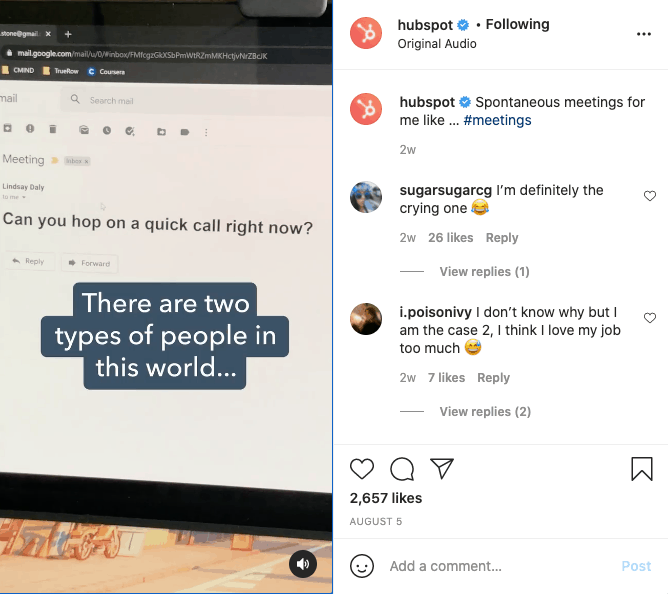
Ultimately, be fun, authentic and relatable – and remember to create content your audience likes – and you won’t go far wrong!
Thanks for reading!
Whew, so there we have it.
There’s no doubting that Instagram is a brilliant platform to reach, engage and inspire your audience, and that its appeal goes way beyond just B2C companies.
Will ALL these ideas be right for you? Will they ALL be a roaring success if you try them? Of course not! Every brand has its own audience, its own flavour, and different tactics will work better for some than others.
But hopefully, the ideas outlined in this post at least give you a shortlist: a bucket of ideas to inspire you, so you can get out there and try some different stuff out, and see what lands best with YOUR audience.
Looking for even MORE inspiration? Check this out: 21 Instagram Story Ideas for Quick Inspiration.
Alternatively, find out how we can help you with video production for Instagram.






